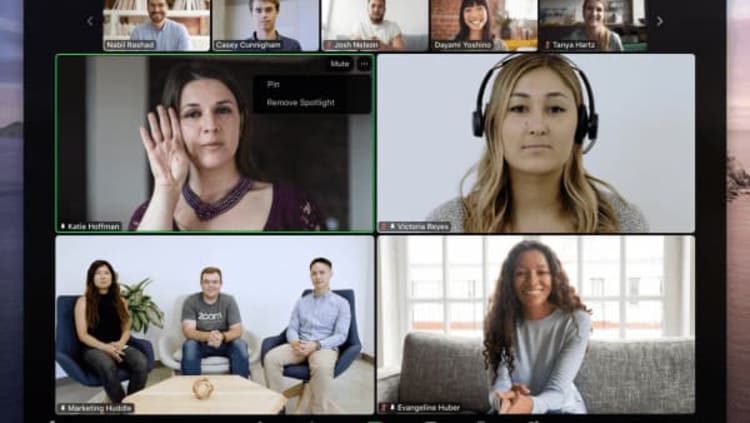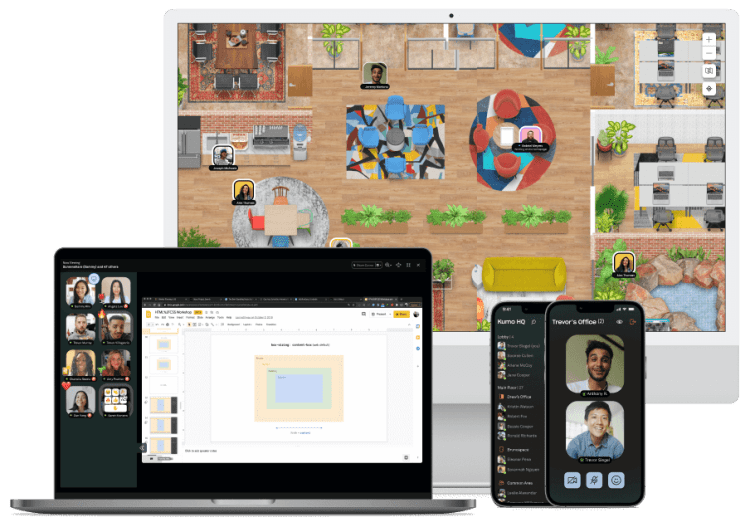In today’s fast-paced business world, effective communication tools are more crucial than ever. As remote work becomes increasingly common, companies need reliable platforms for video conferencing, team messaging, and voice calling. Enter RingCentral, Zoom, and Kumospace - three giants in the world of video conferencing. In this context, the comparison of RingCentral vs Zoom vs Kumospace becomes an important aspect to consider.
In this blog post, we’ll explore the key differences between these leading communication platforms, specifically focusing on RingCentral vs Zoom vs Kumospace, comparing their features, pricing, and unique selling points. Get ready to dive deep into the world of video conferencing and discover the perfect solution for your business needs.
Key takeaways
- RingCentral, Zoom, and Kumospace are three popular video conferencing services, each offering unique features tailored to different communication needs.
- Compare their key features in terms of voice calling capabilities, team messaging/texting, video conferencing competencies & reporting/analytics for the best option.
- Kumospace is a compelling alternative with immersive virtual environments and advanced audio capabilities for more engaging meetings.
RingCentral, Zoom, and Kumospace: an overview

RingCentral, Zoom, and Kumospace are all well-established players in the video conferencing market, but they approach communication differently. RingCentral is primarily a VoIP service provider, offering cloud-based communication services such as phone calls, text messages, and video conferencing through internet protocol. On the other hand, Zoom’s primary focus is on video conferencing, known for its popular Zoom Meetings platform. Kumospace diverges from these models by offering an immersive virtual space replicating real-life interactions and networking. In terms of its key offerings, RingCentral excels in voice calling, providing a tailored business phone number and more customization options. Zoom, stresses video conferencing, with its user-friendly interface and support for many participants in video meetings. Kumospace offers strong spatial audio and video capabilities that enable users to move around virtual rooms and engage in conversations with a more natural feel.
Considering these differences, we will now examine each platform in detail.
RingCentral: a closer look

RingCentral, founded in 2003, is a business communication platform that integrates calling, video conferencing, and team messaging through its mobile apps and desktop applications. It is primarily aimed at organizations that generate a considerable number of calls on a monthly basis. RingCentral’s product offers various features to ensure good communication. These include:
- Toll-free and business phone numbers
- Team messaging
- Voice mail-to-text services
- Document sharing
However, RingCentral also has some limitations. For instance, its essentials plan is restricted to 20 users, and it does not include video conferencing capabilities or 24/7 technical support on the base plan. Depending on your business needs and size, these restrictions may impact your decision when choosing a communication platform.
Zoom: a closer look

Zoom was set up in 2011 and it is popular for its video conferencing platform and cloud-based business phone system, VoIP (Voice over IP). It aids businesses in efficient communications. Zoom’s free plan allows for video conferencing calls of only up to 40 minutes in duration. For those needing VoIP phone calls, Zoom offers a separate service called Zoom Phone, which starts at $10 per month per user.
Zoom’s video conferencing can accommodate up to 100 participants in a meeting with a paid plan, making it suitable for unlimited video meetings. It also offers a variety of features for video conferencing, such as virtual background, keyboard shortcuts, and integration with third-party apps. This makes Zoom an attractive choice for businesses looking to host video meetings with a large number of participants.
Kumospace: a closer look

Kumospace stands out from its competitors in the virtual communication and collaboration market due to its unique approach to creating a more immersive and interactive virtual environment. Unlike traditional video conferencing tools that focus primarily on video and audio transmission, Kumospace offers a distinctive spatial audio experience, where the audio changes as you move closer to or farther from other participants, closely mimicking real-life interactions. This feature greatly enhances the natural flow of conversations, making it easier for users to engage in multiple discussions within the same virtual space, just like at a physical space. Additionally, Kumospace's ability to create customizable and dynamic virtual spaces offers a more engaging and visually appealing experience. This is particularly beneficial for remote and hybrid teams, as it provides a sense of presence and community that is often lacking in standard video conferencing platforms. Furthermore, the platform's intuitive interface and ease of use, without the need for additional software downloads.
These aspects, combined with its focus on enhancing the quality of human interaction in a virtual setting, position Kumospace as a superior choice for those seeking a more engaging and realistic virtual collaboration experience.
Comparing key features: RingCentral vs. Zoom vs. Kumospace

Now that we have a general understanding of both RingCentral and Zoom, it’s time to delve into a more detailed comparison of their features. We’ll be examining key aspects such as:
- Voice calling capabilities
- Team messaging and texting
- Video conferencing competencies
- Reporting and analytics
- Integration possibilities
- Additional plans and add-ons.
The subsequent sections will offer a detailed analysis of each feature to assist you in selecting between RingCentral and Zoom for your business communication demands.
Voice calling capabilities
For voice calling, RingCentral and Zoom both provide advanced features like Interactive Voice Response (IVR), call monitoring, automatic call recording, and Automatic Call Distribution (ACD). However, there are some differences in their offerings, with Zoom providing these features at a more economical price compared to RingCentral, which offers more customizable and filterable analytics and AI-based call routing rules for call recording.
Zoom Phone also holds an advantage with respect to unlimited domestic calling, extending this feature to its users. On the other hand, RingCentral provides more flexible call-distribution rules, which may be more appealing to businesses with specific call-routing needs.
Team messaging and texting
RingCentra, Zoom and Kumospace all offer team chat and file sharing features, fostering efficient communication and collaboration within your team. RingCentral’s task management feature is seamlessly integrated with its messaging platform, providing an added layer of organization for your team’s projects.
In contrast, Zoom Phone offers unlimited SMS and unlimited calls, allowing users to send and receive messages with any U.S. or Canadian telephone number domestically. This feature can be especially useful for businesses that need to communicate with customers or clients via text, providing an additional communication channel to better serve their needs.
Kumospace, on the other hand, also offers a team chat feature that enhances team collaboration and interaction. Its distinct approach includes immersive virtual spaces where team members can interact more naturally, akin to a physical office environment. This could potentially make team communication more engaging and organic, fostering a sense of community and teamwork. Kumospace combines asynchronous and synchronous communication all in one platform to handle all of your team's needs.
Video conferencing competencies
Zoom supports more participants and offers various collaborative features such as polls, live streaming, and translated captions. This makes it a good choice for sales team meetings, where engaging and interactive sessions are key to success.
RingCentral offers virtual assistance tools in its AI Meetings, such as automated summaries and highlight reels. This makes it a great option for business meetings or teleconferences. While not as feature-rich as Zoom, RingCentral’s video conferencing capabilities may still prove valuable for businesses looking for a more streamlined and focused meeting experience.
Kumospace excels in creating immersive virtual office spaces, significantly enhancing the remote work experience. Unlike traditional video conferencing tools, Kumospace focuses on replicating the dynamics of a physical office in a digital environment. This setup allows team members to move around in a virtual space, facilitating spontaneous interactions and more organic conversations, akin to what one would experience in a real office. The platform's spatial audio feature enables conversations to become more private and context-specific, as the audio volume adjusts based on the virtual proximity of the participants.
Reporting and analytics
Reporting and analytics are pivotal in aiding businesses to make data-driven decisions and enhance their communication workflows. RingCentral’s business analytics provides increased personalization, data visuals, and additional metrics compared to Zoom’s Analytics. However, it’s important to note that only RingCentral’s Advanced and Ultra plans include analytics.
Zoom, on the other hand, supplies more fundamental analytics across all plans, allowing businesses of all sizes to access valuable data insights. For those looking for more advanced analytics, Zoom offers the option to upgrade to its Zoom One license, granting system admins access to detailed usage reports and metrics. Kumospace, focusing on virtual office environments, offers analytics centered on user engagement within its platform. Specifically, it provides insights on how long users stay engaged on the platform, which can be a critical metric for businesses monitoring virtual office use. This feature is particularly valuable for organizations looking to optimize their remote or hybrid work models and ensure their virtual office space meets the team's needs effectively.
Integration possibilities
Integration possibilities are crucial for businesses seeking to streamline their workflow and optimize their communication processes. RingCentral offers integrations with Microsoft Outlook and Google Contacts accounts, as well as development tools such as Jira, Travis CI, and Github, and marketing automation tools like Marketo. In total, RingCentral boasts over 300 prebuilt third-party integrations and can be connected to popular applications through Zapier.
Zoom has more than 2000 integrated applications. With such an extensive array of integration possibilities, Zoom allows businesses to seamlessly connect their existing tools and processes, fostering a more efficient and unified platform for communication and collaboration.
Kumospace, enhancing its usability in virtual office environments, has integrated with key productivity tools such as Microsoft Outlook Calendar, Microsoft Teams, Google Calendar, and Hopin. These integrations facilitate seamless scheduling and integration into existing workflows, making it easier for users to organize and participate in virtual meetings and events within the Kumospace platform. This added convenience helps to ensure a smoother, more cohesive virtual office experience.
Additional plans and add-ons
Both RingCentral and Zoom offer a variety of additional plans and add-ons for businesses with unique needs or requirements. RingCentral has additional plans to offer its customers a range of services. These include webinars, AI live-agent support, and contact center solutions. Zoom provides a range of additional services, such as real-time queue analytics, international calling to 19 countries, and a contact center. These features set Zoom apart from other platforms.
These additional plans and add-ons can provide enhanced functionality and capabilities to businesses, allowing them to tailor their communication platform to better suit their specific needs. These options should be taken into account when contrasting RingCentral and Zoom, to make sure you opt for the solution that corresponds best with your business needs.
Pricing comparison: RingCentral vs. Zoom vs. Kumospace

In terms of pricing, there are notable differences between RingCentral, Zoom and Kumospace. RingCentral’s Core plan begins at $30 per user per month, while the Advanced plan is available for $35 per user per month. In comparison, Zoom’s business phone systems are more cost-effective, starting at $10 per user per month.
Understanding the pricing structures of both platforms is crucial when making your decision. While RingCentral may offer more features, its higher price point may not be suitable for all businesses, especially smaller ones. On the other hand, Zoom’s more affordable pricing may make it a more attractive option for businesses looking to minimize costs while still benefiting from a robust communication platform.
Kumospace, in comparison, has a Free Plan for small teams and a Business Plan at $16 per user per month, with an Enterprise Plan available at a variable price, offering features like single sign-on and HIPAA compliance.
RingCentral pricing plans
RingCentral offers three pricing plans for its MVP product: Core, Advanced, and Ultra, starting at $20, $25, and $35 per user per month, respectively. These plans include various features and functionalities, such as toll-free numbers, team messaging, voicemail-to-text services, and document sharing.
One should note that RingCentral provides discounts for annual subscriptions, which could lead to some cost savings for businesses that agree to a longer-term contract. However, it’s essential to carefully consider the features included in each plan and weigh them against your business’s specific needs and budget.
Zoom pricing plans
Zoom offers a free plan with limited video conferencing capabilities, as well as paid plans starting at $14.99 per user per month. For businesses requiring VoIP phone calls, Zoom Phone starts at $10 per user per month and includes features such as unlimited calling within the U.S. and Canada, voicemail with transcription, unlimited auto attendants, and advanced call handling.
In addition to its core plans, Zoom also offers add-ons and supplementary plans for businesses with specialized requirements, such as real-time queue analytics and international calling to 19 countries. Similar to RingCentral, it is important to thoughtfully evaluate the features and pricing of Zoom’s plans to confirm they match your business’s needs and budget.
Kumospace pricing plans
Kumospace provides a Free Plan for small teams and a Business Plan at $16 per user per month, alongside a variable-priced Enterprise Plan with additional features like single sign-on and HIPAA compliance. Each platform's pricing reflects its unique features and capabilities, making it important for businesses to consider their specific needs and budgets when choosing a solution.
Pros and cons: RingCentral vs. Zoom

Summarily, RingCentral and Zoom each have their own strengths and weaknesses. RingCentral offers a more comprehensive and feature-rich communication platform, particularly in terms of voice-calling capabilities and customization options. However, its higher price point and limitations on the Essentials plan may be prohibitive for some businesses.
Zoom, on the other hand, excels in the area of video conferencing and offers a more affordable pricing structure. Its user-friendly interface and support for a higher number of participants in a video meeting make it an attractive choice for businesses looking to host video meetings with ease.
Ultimately, the decision between RingCentral and Zoom will depend on your business’s specific needs and budget constraints.
Kumospace: a compelling alternative
While RingCentral and Zoom are both strong contenders in the video conferencing market, there’s a better player on the market that’s worth considering - Kumospace. This innovative platform offers a unique and immersive approach to communication, focusing on creating virtual spaces that replicate real-life interactions.
Kumospace’s features that distinguish it from its competitors include:
- Spatial audio capabilities
- Immersive virtual environments
- More engaging and interactive meetings and collaborations
- Fostering a deeper sense of connection among participants
Key features of Kumospace
Kumospace offers a truly immersive and interactive virtual environment for meetings and collaborations, leveraging spatial audio to create a natural and realistic virtual setting. Its environment provides engaging team collaboration opportunities, allowing participants to communicate through video and audio conferencing in a distinctive and innovative way.
Beyond its innovative approach to video conferencing, Kumospace also provides seamless integration with popular tools, such as Google Workspace, enabling your team to maintain connectivity and work effectively within the platform. Some of the key features of Kumospace include:
- Immersive virtual environment
- Interactive whiteboard
- Screen sharing
- File sharing
With its distinctive blend of features and immersive virtual environment, Kumospace emerges as a persuasive alternative to conventional video conferencing platforms.
Why Choose Kumospace?
Kumospace’s focus on replicating real-life interactions in a virtual setting makes it an appealing choice for businesses looking to foster deeper connections among team members and enhance productivity. By cultivating a sense of community and camaraderie within the platform, Kumospace encourages more meaningful and engaging interactions among participants.
Moreover, its immersive virtual workspaces and advanced features, such as real-time polling for expedited feedback, make it an ideal choice for teams seeking a more interactive and collaborative meeting experience. In an increasingly remote work landscape, Kumospace offers a refreshing and innovative approach to virtual communication, setting itself apart from the competition.
Summary
In conclusion, RingCentral, Zoom, and Kumospace each offer their own unique advantages and disadvantages in the video conferencing market. RingCentral excels in providing a business phone system, while Zoom has a user-friendly video conferencing capabilities. Meanwhile, Kumospace presents a revolutionary approach to virtual communication, focusing on replicating real-life interactions in an immersive and engaging virtual environment. They enhance virtual communication by creating more natural, interactive experiences that closely mimic real-life interactions, fostering better connections among users.
Ultimately, the choice between these platforms will depend on your business’s specific needs, budget, and priorities. By carefully assessing the features, pricing, and user experiences offered by each platform, you can make an informed decision and select the communication solution that best aligns with your company’s requirements.
Frequently asked questions
Based on customizable and filterable analytics, plus AI-based call routing rules offered by RingCentral, as well as Zoom's plans with phone and chat, video and chat, or all three communication channels, we would recommend RingCentral for a better overall experience. Kumospace is the best alternative, which enhances productivity and collaboration in the remote work world.
RingCentral and Zoom have reached an agreement, ending the legal proceedings between them. This indicates that RingCentral is no longer using Zoom.
RingCentral is a powerful cloud phone system that offers total call control, including customizable and filterable analytics, AI-based call routing rules, call forwarding, call flip, call screening, multisite management, and other calling features. It also provides integrated SMS, eFax, messaging, and video meetings in one single app. As a result, RingCentral offers a better end-user experience at a lower CAPEX and with continuous innovation.
Yes, RingCentral offers video conferencing capabilities, though they may not be as feature-rich as some of its competitors.
Kumospace offers an immersive virtual environment for meetings and collaborations with spatial audio capabilities, allowing users to replicate real-life interactions in a virtual setting.





